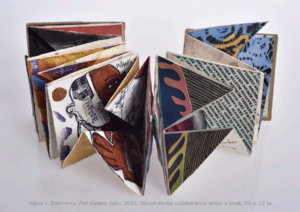9 Artists/ 9 Months/ 9 Perspectives features work by the collective, Dandelion Black Women Artists.
OPENING RECEPTION RSVP HERE
Nine Black women artists engaged in collaborative efforts to create artworks that transcend and transform events in the year 2020. In their eyes, art-making became a transgressive act through activism, documentation and vision. Utilizing book-making, craft-making and works on paper, 9 Artists/9 Months/ 9 Perspectives presents a birth of vision under hardship felt worldwide, collectively allowing us to reckon with our own perspectives, reflections and welfare.
This exhibition presents the conception, gestation, and birth of a collaborative artists’ books created by nine Black women artists of the collective, Dandelion Black Women Artists. Their responses, perspectives, and reflections were inspired by the continuous struggle for health, social, and economic welfare of marginalized people during COVID-19, the lack of response from the federal government, and the political allyship of socio-political grassroots movements like Black Lives Matter. Craft-making became a transgressive act through artivism, perspective, and vision.

Their work embraces Black feminism as theorized by artist/art historians such as Freida High Wasikhongo Tsesfagiorgis, in which art created by Black women artists depict the Black woman as: 1) subject rather than an object; 2) the exclusive or primary subject; 3) active rather than passive; 4) sensitive to the self-recorded realities of Black women; 5) imbued with the aesthetics of the African continuum—sustaining a personal vision that embraces Afrocentric tastes in color, texture, and rhythm.
Exhibiting artists include:
Adjoa J. Burrowes, Julee Dickerson-Thompson, Aziza Claudia Gibson-Hunter, Michele Godwin, Francine Haskins, Pamela Harris Lawton, Gloria Patton, Gail Shaw-Clemons, and Kamala Subramanian.
9 Artists/ 9 Months/ 9 Perspectives will be on view from October 8 – December 17, 2022.



